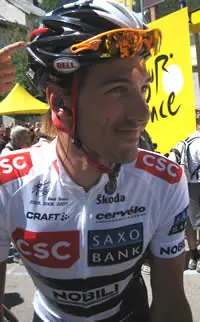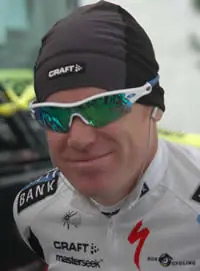The Tour of Flanders and Paris-Roubaix are commonly referred to as the "cobbled classics", most notably because they contain long sections of cobblestone roads. The key to success in these races is being able to ride the cobbles both efficiently to save energy and skillfully to avoid crashing.
The 160-mile Paris-Roubaix race includes thirty miles of cobbles spread across about 25 sections ranging from 400 meters to almost two miles. Also, all cobbles sections are not created (or have deteriorated) equally. The race organizers rate each section from one to five stars. The five star sections have the worst cobbles and are barely rideable.
The 165-mile Tour of Flanders has 13 miles of cobbles, with the Paddestraat at about two miles and the Mater at about one and a half miles being the main flat sections. However, unlike Roubaix, many of the race's fabled hills are also cobbled, with the Koppenberg, Patersberg and Oude Kwaremont being particularly memorable for their steepness (20+ percent grade) and difficulty.
Mere mortals can learn a lot from the pros who ride these races. To be sure, most cyclists will never get a chance to race Paris-Roubaix or Tour of Flanders, but the skills necessary to ride the cobbles can help you with bumpier pavement sections and dirt road riding.
Follow Those Who Know

Fabian Cancellara
Fabian Cancellara has won both Paris-Roubaix and Tour of Flanders. Just like the rest of us, Cancellara had to learn how to ride the "stones."
"When I started riding these races they told us you have to ride right behind the champions who have won the races before because they are in the front and have people who keep them in the front," he once told me. "Sometimes you learn a lot from them. But, now I have to say that I am in the situation where I am one of them."
Stuart O'Grady, who won Paris-Roubaix in 2007, agrees. "I remember when I started out and tried to follow [Andrei] Tchmil and [Peter] Van Petegem in Flanders. My objective for the whole day was just to follow those guys. Be their shadow. It was impossible. I couldn't believe it. One minute I am there behind them and the next minute I am in 80th and they are sitting in the first five. I was asking myself 'how the hell do they do that?'"
Save Your Strength
Cancellara, the 2006 Paris-Roubaix and 2010 Tour of Flanders winner, describes how he rides the cobbles: "Be in the best shape to cross over the cobbles until the end of each section, because if you get tired you are going to blow up in the cobbles, not after. You need to have good speed, the right position and the right cadence because if you have too high of a cadence you jump. If you have too low of a cadence you blow. If you have the right cadence you float."

Stuart O'Grady
Easier Is Not Always Better
O'Grady offers a few extra pointers. "The best way is to ride straight down the middle of the road. It is the hardest, but it is the best. When riders start getting a bit tired or a bit desperate they dive off into the sides or into the dirt because it is a little bit easier ride, but that is where the rocks get flicked into and all the punctures are going to happen. The guys riding down the center of the road generally are the guys who are going pretty strongly."
The Bottom Line
If all that advice seems difficult to digest, here's the executive summary:
"The slower you go, the worse it is. You have to go fast to smooth out the bumps," said Cancellara.
"The faster you go the easier it is. The problem is the more tired you get the slower you get, so the harder they become," adds O'Grady.


